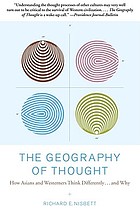preparations for 25 September session

Read these
Nisbett, R. E. (2004). The geography of thought: How Asians and Westerners think differently – and why. New York: Free Press.
-
"Eyes in Back of Your Head" or "Keep Your Eye on the Ball"?:
Envisioning the World,
p. 79 through 109 -
"The Bad Seed" or "The Other Boys Made Him Do It"?:
Causal Attribution and Causal Modeling East and West,
p. 111 through 135
Think about these issues
Westerners and Asians literally see different worlds. Like ancient Greek philosophers, modern Westerners see a world of objects - discrete and unconnected things. Like ancient Chinese philosophers, modern Asians are inclined to see a world of substances - continuous masses of matter.
How do you fit into this description? Do you see the forest for the trees?
The atomistic attitude of Westerners extends to their understanding of the nature of social institutions ... the social attitudes and values of continental Europe are intermediate between East Asian and Anglo-American ones ... The big-picture ideas are much rarer in Anglo-America than on the Continent.
Is this school, for example, an integrated whole or a series of interacting parts?
Have you ever heard of "works councils" or "co-determination"?
Can you accept these characteristics of "Western Utopias"?
there is a steady, more or less linear progress toward them
once obtained, they become a permanent state
they are reached through human effort rather than Fate or divine intervention
they are usually egalitarian
they are usually based on a few extreme assumptions about human nature
Westerners attend primarily to the focal object or person and Asians attend more broadly to the field and to the relations between the object and the field. Westerners tend to assume that events are caused by the object and Asians are inclined to assigne greater importance to the context.
Did the author substantiate his points?

